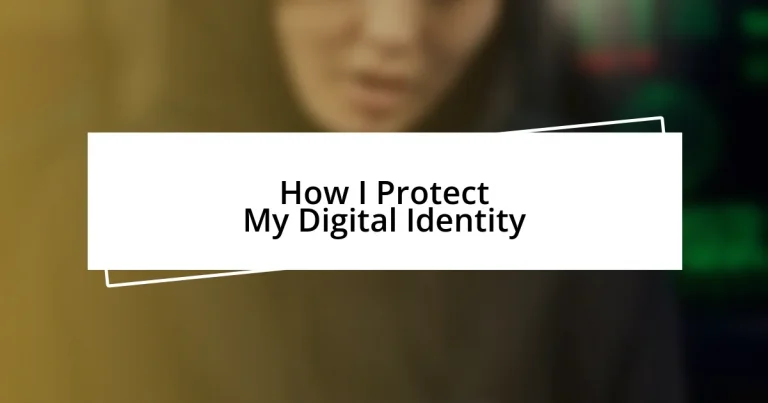Key takeaways:
- Awareness of digital identity risks, such as identity theft, public Wi-Fi vulnerabilities, and phishing scams, is crucial for protecting personal information.
- Utilizing strong passwords and two-factor authentication adds significant layers of security to online accounts, reducing the risk of unauthorized access.
- Regularly monitoring online presence and responding promptly to identity theft incidents can help maintain control over one’s digital identity and mitigate potential damage.
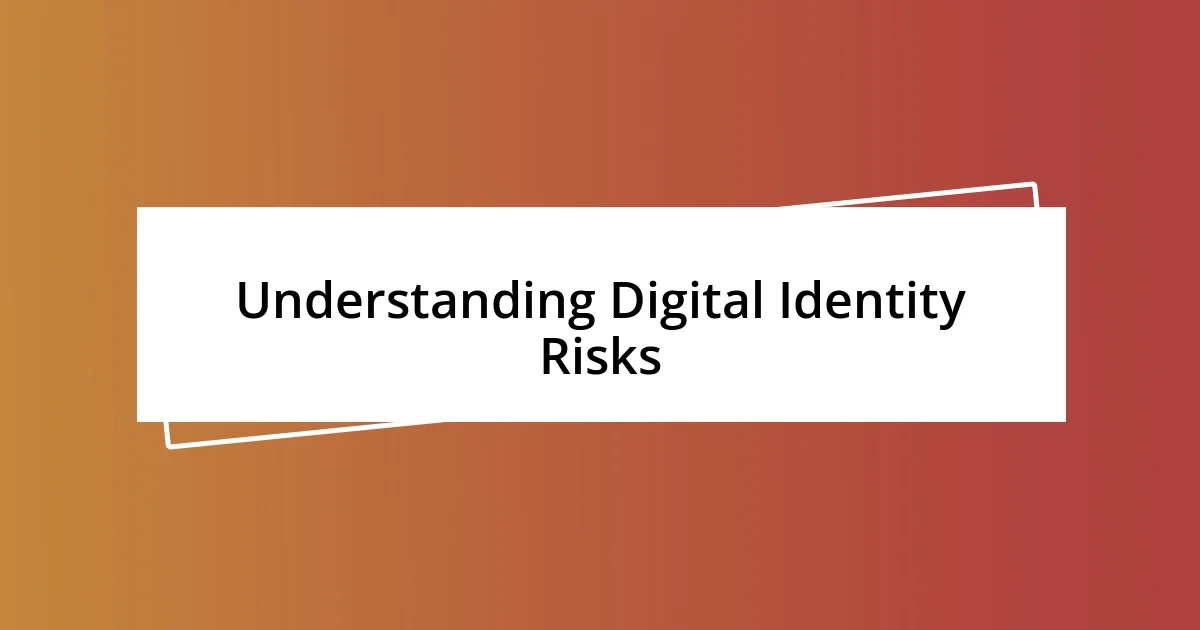
Understanding Digital Identity Risks
When I think about digital identity risks, I often recall that moment when I realized my personal information was scattered across multiple platforms. It was unsettling to discover how much I had exposed without even knowing it. Have you ever stopped to consider what happens to your data once it’s out there? That casual post or seemingly harmless comment could be a gateway for cybercriminals.
One of the scariest risks I’ve faced was the potential for identity theft. A few years back, a close friend experienced a breach when someone accessed their email account and started impersonating them. This incident drilled home the point for me: our digital footprints are more extensive than we think and can be manipulated in ways we can’t imagine. How vulnerable do you feel knowing that each online interaction leaves a mark?
I’ve also noticed how easy it is to underestimate the risks associated with public Wi-Fi. Early in my career, I used a coffee shop network without a second thought, only to learn later that it was a hotbed for cyberattacks. It leaves me wondering—are we too complacent about keeping ourselves safe in a world that thrives on connectivity? Recognizing these risks is the first step in protecting ourselves and our digital identities.
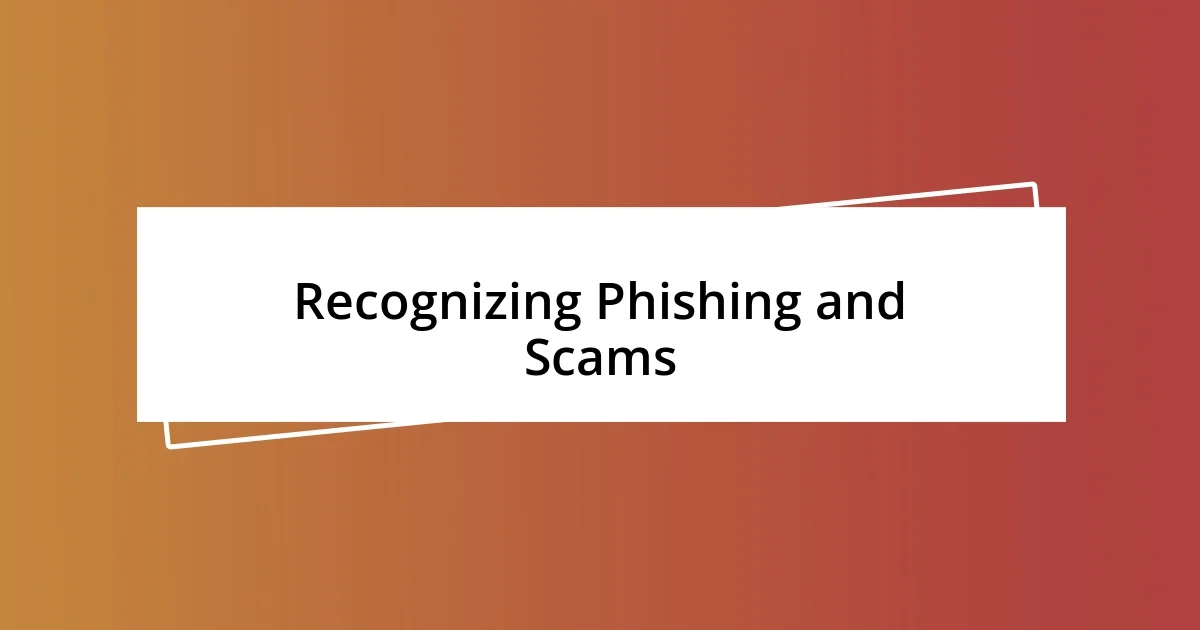
Recognizing Phishing and Scams
Phishing scams can be incredibly deceptive, and I’ve had my share of close calls. I remember receiving a seemingly authentic email from my bank urging me to update my information. The sense of urgency in the message almost swept me in. My heart raced, and I hesitated, only recognizing later that the email’s sender wasn’t even my bank! This experience taught me the importance of scrutinizing the sender’s address and looking out for any unusual requests or poor grammar, which often hint at something amiss.
To help you stay alert, here are some common indicators of phishing and scams:
- Unusual Email Addresses: Be cautious if the sender’s address looks slightly off or unfamiliar.
- Spelling and Grammatical Errors: Legitimate companies usually proofread their communication.
- Urgent Language: Phishing attempts often create a false sense of urgency to provoke hasty actions.
- Links to Suspicious Websites: Hover over links to see the actual URL before clicking.
- Generic Greetings: Watch for vague salutations; a personalized greeting usually indicates authenticity.
Recognizing these signs has been crucial for me, as it can save not just time, but also stress and potential financial loss.
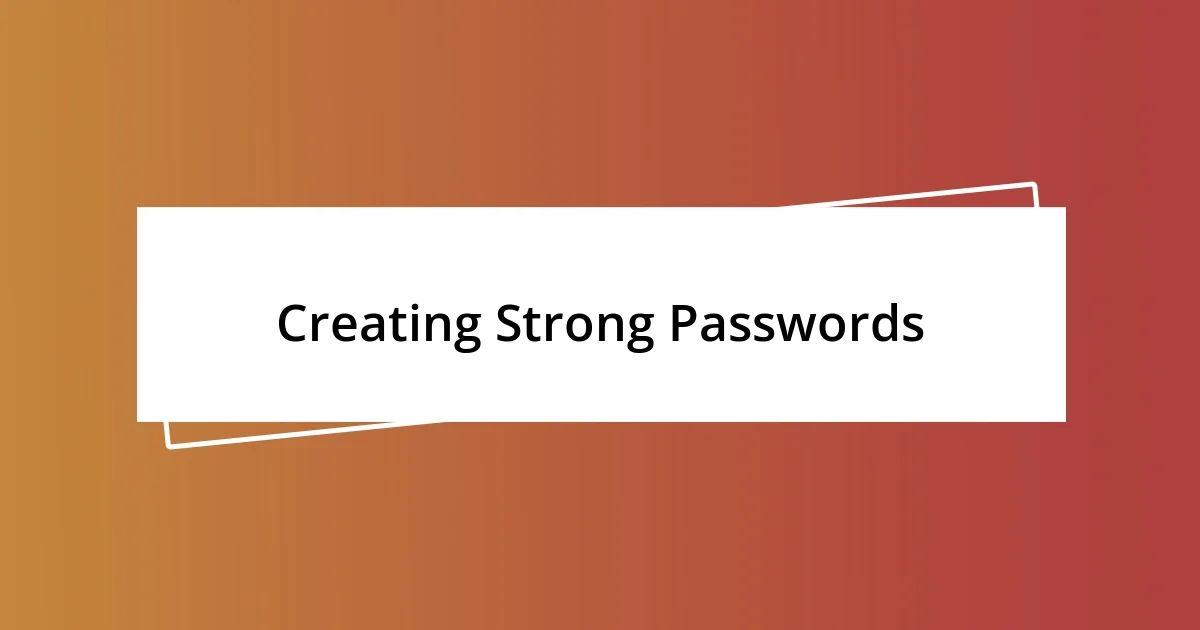
Creating Strong Passwords
When it comes to creating strong passwords, I’ve learned that they serve as the first line of defense for my digital identity. Initially, I used simple, easy-to-remember passwords, which seemed convenient. However, after hearing about data breaches not just in large companies but also in apps I used, I realized I needed to up my game. It was an eye-opener—my digital safety depended on a few characters typed into a box.
These days, I embrace the use of long and complex passwords that combine letters, numbers, and special characters. For example, instead of a simple password like “Mountain123,” I now aim for something like “M0unt@in!2023Ch!ll3ng3.” Not only does this make it nearly impossible for someone to guess, but it also reflects a commitment to safeguarding my information. I even utilize phrases or sentences I can remember but translate into something unique and personal. Have you ever tried this method? It can add a fun twist while enhancing security.
I also recommend using a password manager. It reduces the chance of reusing passwords across different accounts, which is a common pitfall. I remember nervously trying to recall my passwords for various sites, leading to the dreaded password reset cycle. With a password manager, I can keep my digital life organized while focusing on being creative and secure. It’s an easy-to-use tool that provides a safety net for all my digital combinations.
| Password Example | Strength Level |
|---|---|
| Mountain123 | Weak |
| M0unt@in!2023Ch!ll3ng3 | Strong |
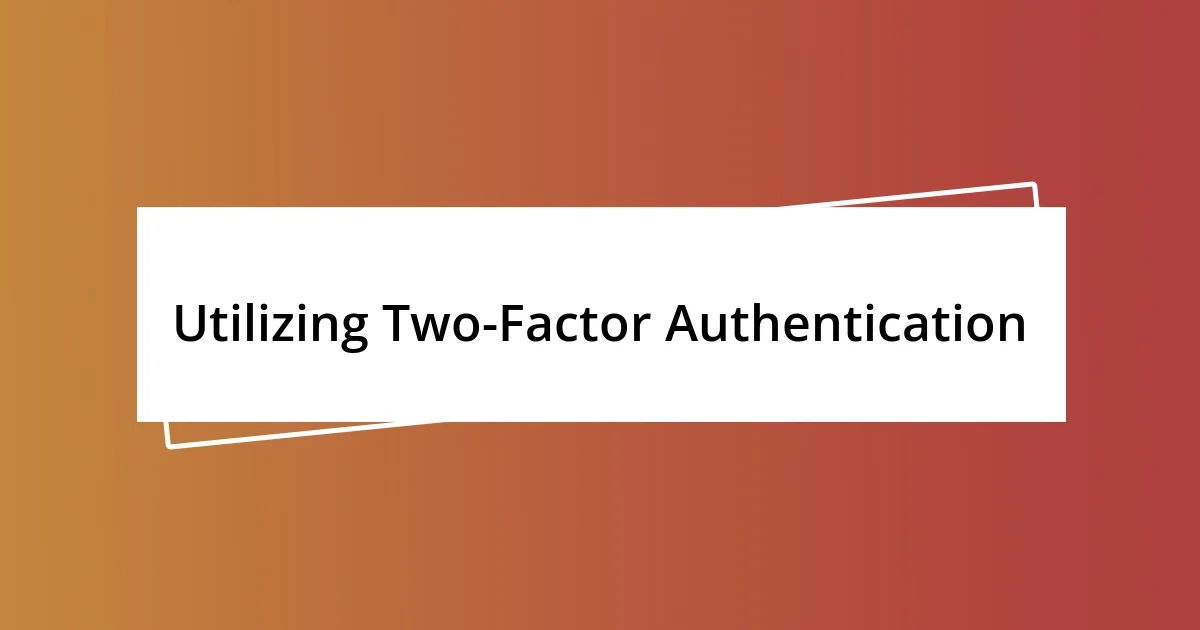
Utilizing Two-Factor Authentication
Utilizing Two-Factor Authentication
Two-factor authentication (2FA) has become a pivotal step in my personal cybersecurity strategy. I remember the relief I felt when I activated it on my email account after hearing about a friend’s unfortunate experience with hackers gaining access to their sensitive information. It’s like having a bouncer at the door—just because someone has the key (or password) doesn’t mean they’re granted entry without a proper check.
Whenever I log in, I appreciate that extra layer of security. Often, I receive a text or an authentication app prompt, and it’s a small yet significant pause that makes me feel more in control. I once made the mistake of skipping 2FA on a new social media account, thinking it was unnecessary—until I noticed suspicious activity a week later. That moment was a wake-up call, reminding me that it only takes one lapse in security to put my digital identity at risk.
Have you ever thought about how many services offer 2FA? It’s astonishing how many people still overlook this feature, and honestly, I get it—sometimes it feels like an extra step. However, I value those few moments of verification knowing they could prevent the frustration of dealing with potential breaches. Now, I can’t imagine logging in without it, and I highly encourage everyone to integrate 2FA wherever possible. The peace of mind it provides is absolutely worth those extra seconds each time I log in.
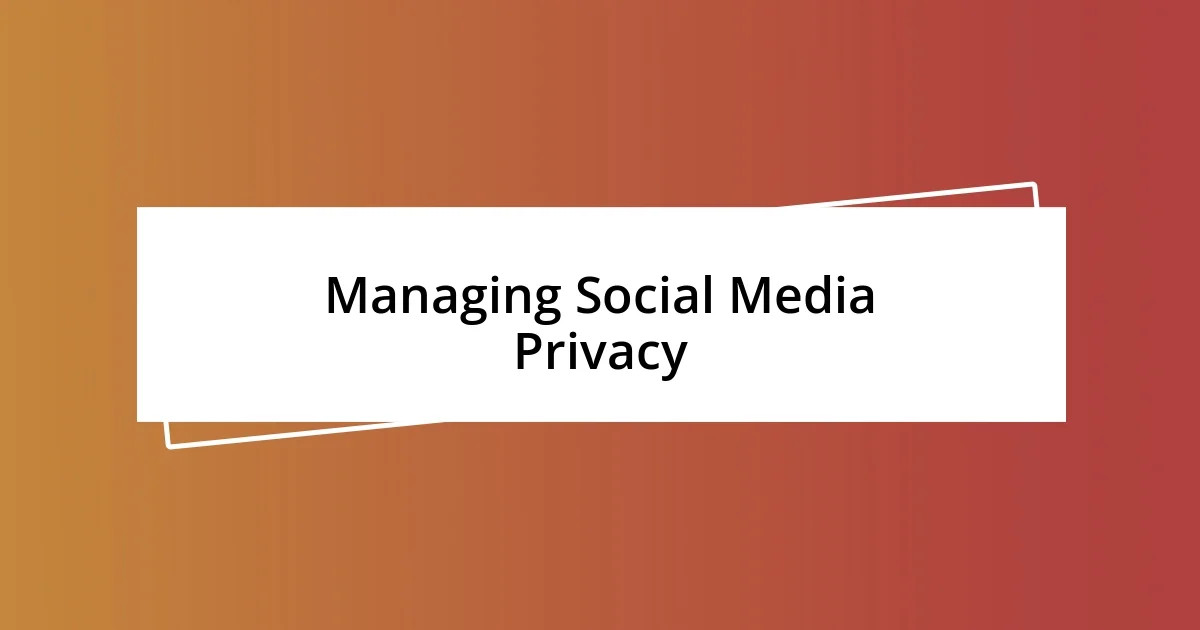
Managing Social Media Privacy
Managing social media privacy feels like navigating a wild jungle at times. When I first joined various platforms, I didn’t pay much attention to privacy settings. I mean, how harmful could sharing a few photos be? Then, I stumbled across an old post tagged by a friend that I certainly wouldn’t want an employer to see. That was a lightbulb moment for me—it made me realize just how quickly things can spiral out of control if I’m not careful.
Now, I routinely review my privacy settings on each social media account, ensuring only the people I trust can see my posts and personal information. I remember the time I switched my Instagram profile to private after realizing that anyone could follow me and access my life updates without my consent. It felt liberating to take control. Have you done this? Trust me, it’s a small change that goes a long way in securing your digital persona.
Another tip I’ve found effective is being selective about friend requests. There was a period when I accepted requests from anyone who clicked “Add.” I learned the hard way when I started receiving unsolicited messages from strangers. Now, I ask myself, “Would I go for coffee with this person?” If the answer is no, I don’t accept the request. This simple mental check not only enhances my privacy but also helps me curate my online community to those who truly enrich my experience. What about you? Have you ever found yourself in a similar situation?
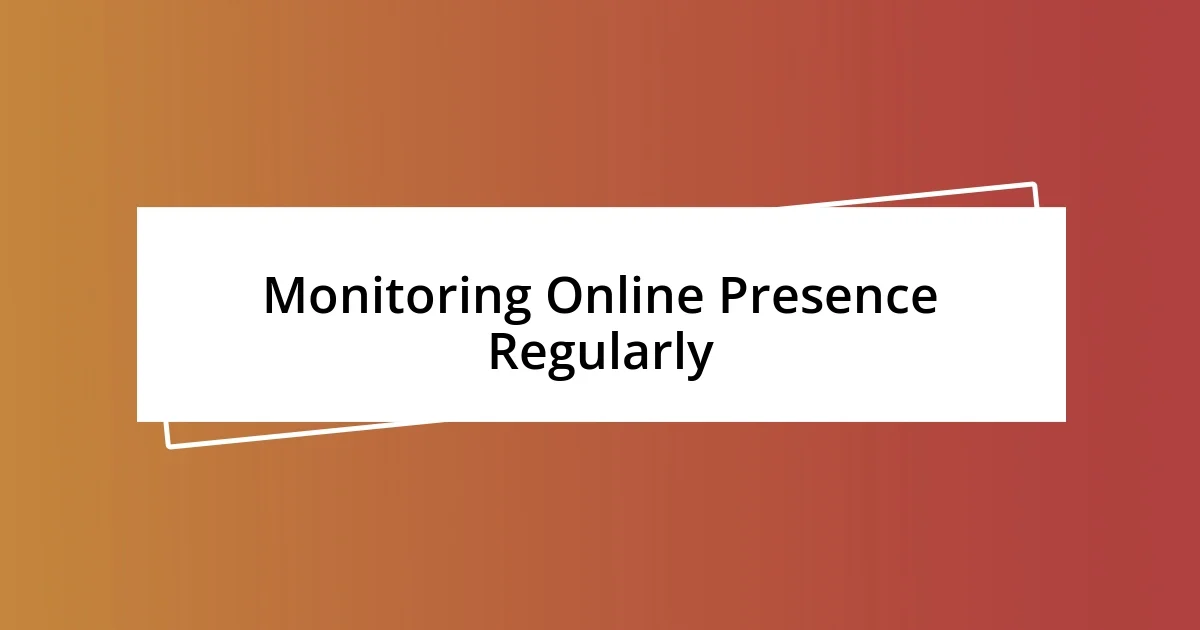
Monitoring Online Presence Regularly
Monitoring my online presence regularly is something I’ve come to prioritize deeply. When I first began this practice, it was a bit overwhelming. I recall the sinking feeling when I discovered old blog posts from my college days that no longer reflected who I am. Has that ever happened to you? It’s a stark reminder of how our digital footprints can linger long after we’ve moved on.
Now, I’ve made it a habit to Google myself every few months. This simple search has revealed surprising information—like outdated images or comments that have the potential to paint an unfavorable picture. I remember one instance when a harmless photo from years ago popped up, taken at a party where I’d let my hair down—literally. I quickly learned the importance of not just watching my social media, but also understanding what’s floating around the web. It’s crucial to stay informed.
I’ve also signed up for alerts that notify me whenever my name or email address appears online. This added layer of monitoring has not only helped me stay on top of my digital presence but has also provided peace of mind. Do you keep track of what’s said about you online? Knowing I can act quickly if something concerning arises makes me feel more in control of my identity. In this ever-evolving digital landscape, maintaining awareness of my online persona has become an empowering habit I encourage everyone to adopt.
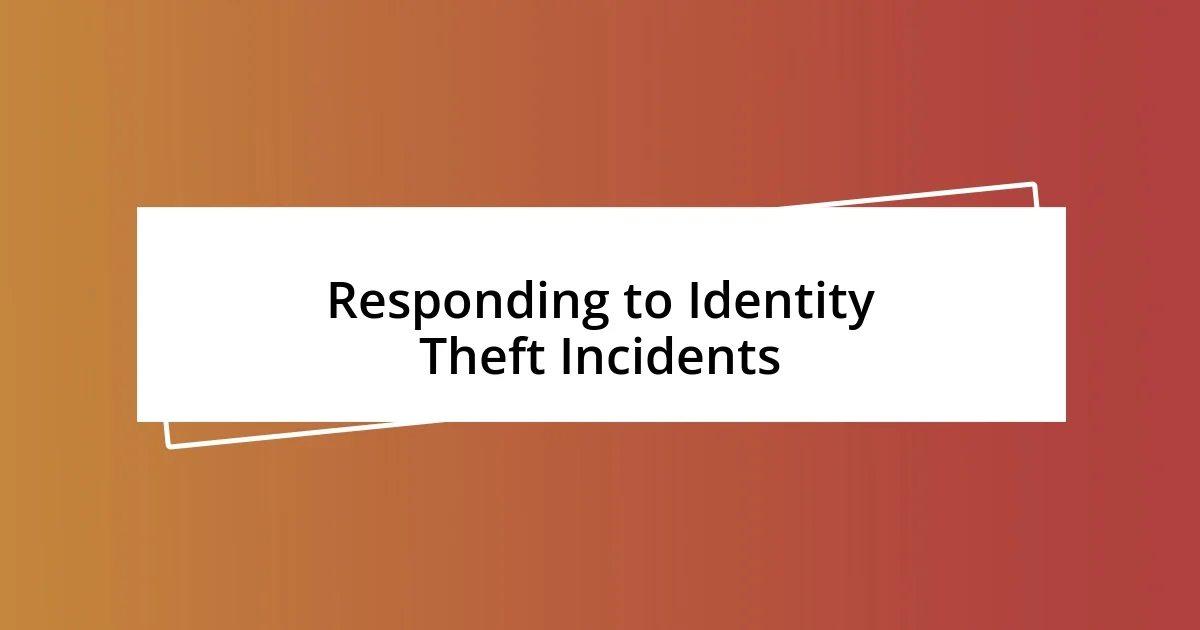
Responding to Identity Theft Incidents
Responding to identity theft incidents can feel like a whirlwind of confusion and fear. I remember when I first realized my personal information had been compromised; it was unsettling to see fraudulent charges on my credit card statement. My immediate reaction was to freeze, but I quickly learned that taking swift action matters. Have you ever found yourself in a similar situation? The first step is always to contact your bank or credit card company to dispute any unauthorized transactions.
As I dug deeper into the recovery process, I discovered the importance of placing a fraud alert on my credit report. It was a small action that made a huge difference. By notifying the credit bureaus, I was able to make it harder for identity thieves to open new accounts in my name. It’s a proactive measure that empowered me to take control of the situation. How about you? Have you heard of fraud alerts before? They really help in safeguarding against further issues.
Finally, I realized the significance of reporting the identity theft to authorities, such as the Federal Trade Commission (FTC) in the U.S. Getting a copy of the identity theft report felt like I was reclaiming my narrative. It was an essential step in clearing up the chaos and establishing my rightful identity. If you’re ever in this position, don’t hesitate to document everything—you’ll want a paper trail. It’s a tough experience, but taking these actions can get you back on track and restore your peace of mind.












